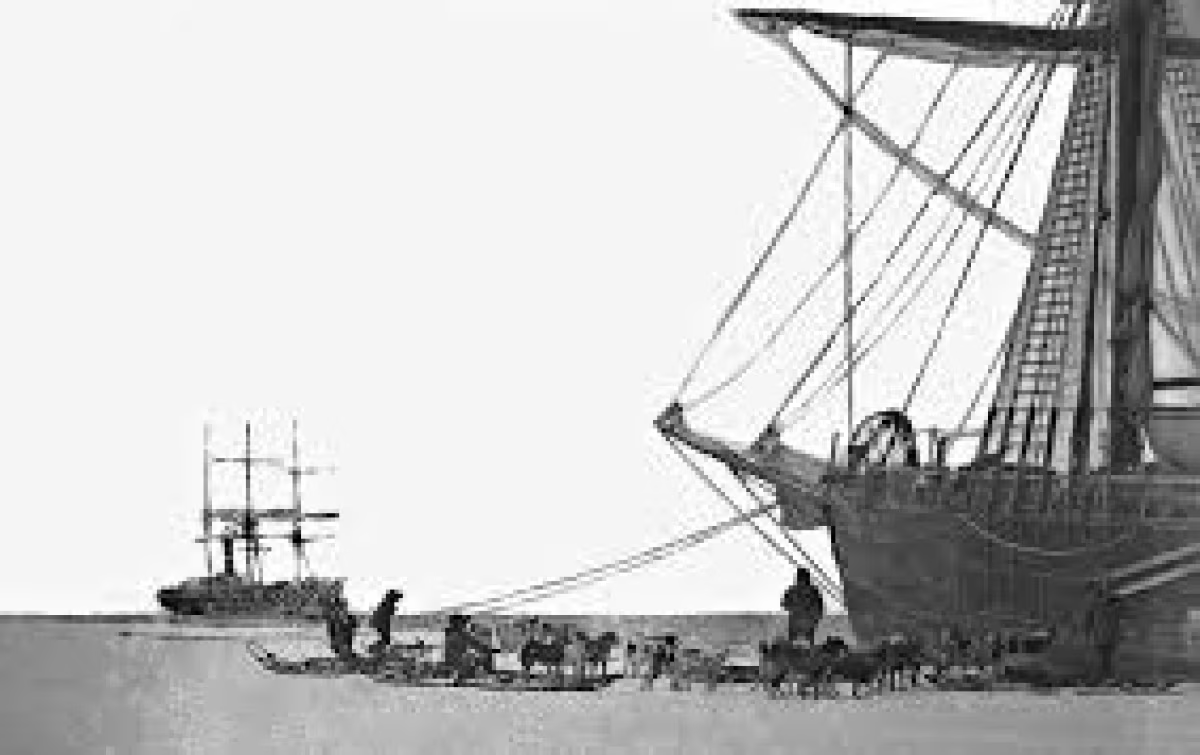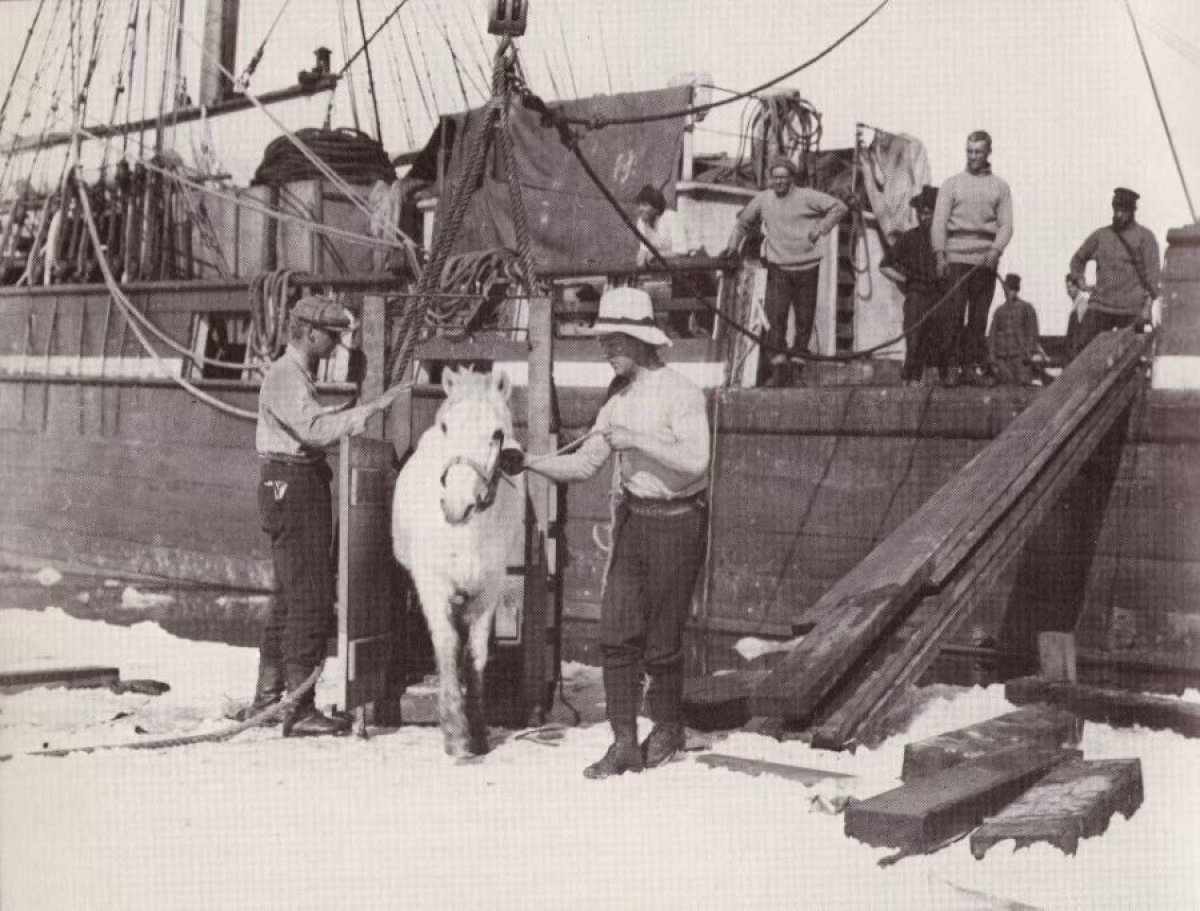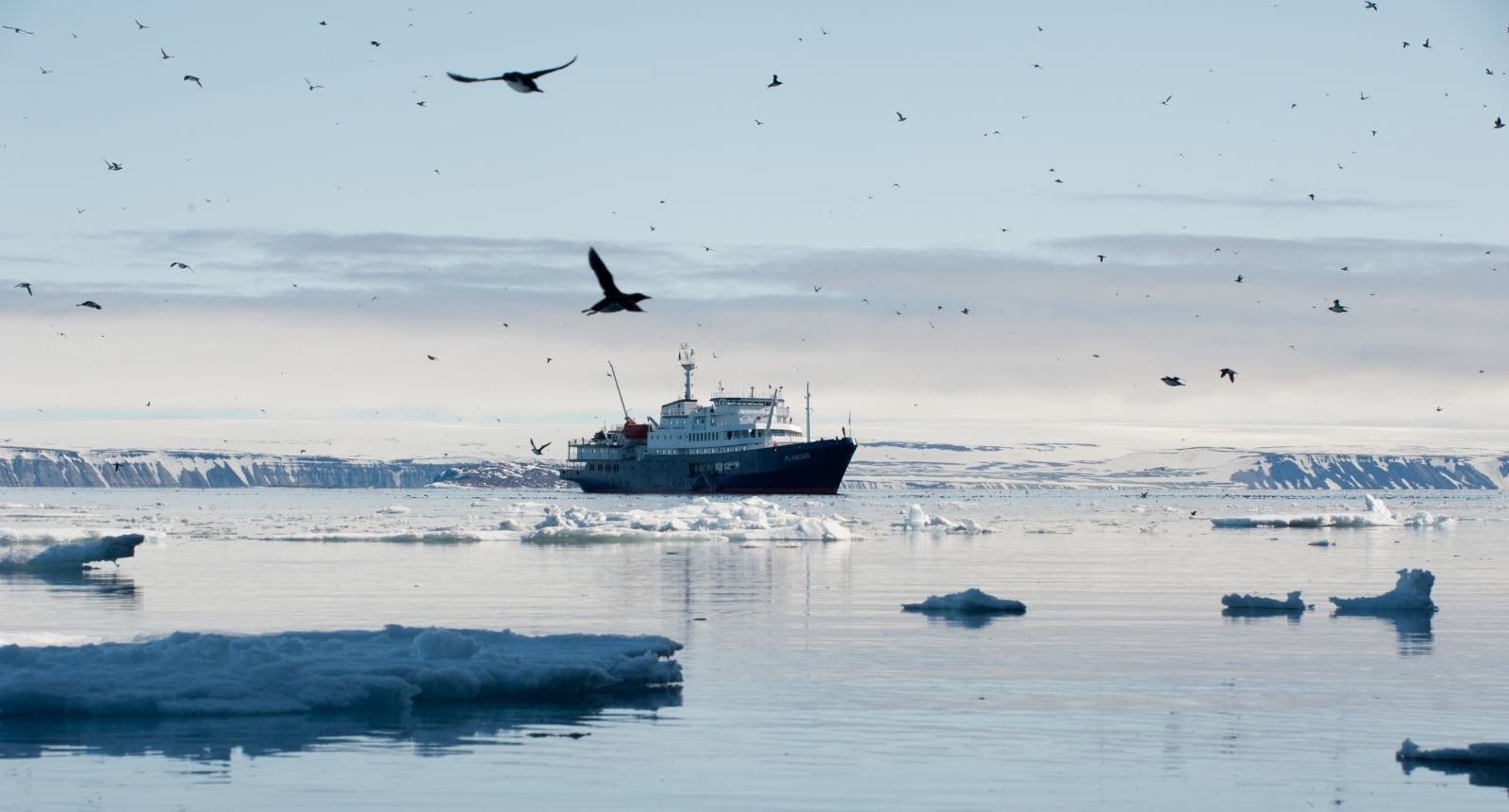Scott’s ponies becoming unstuck
On January 26 1911, the Terra Nova departed for the eastern end of the ice barrier to drop Lieutenant Victor Campbell and his five-man team off, where they would act as an ‘independent command’ undertaking inland exploration wherever possible. The ship encountered difficult conditions and heavy ice and so on the morning of February 3 the crew, still looking for a suitable place to land the party, took the ship into the Bay of Whales where they saw Fram quietly anchored in the sea ice.
An officer on the Terra Nova noted ‘’curses loud and deep were heard everywhere’’ onboard. Campbell, who spoke Norwegian, called out to the watchmen on Fram who was equally started to see the British ship. The Norwegians, at first unsure what to expect, felt less threatened by the friendly Campbell and so invited their rivals over and suggested where the British could camp, even offering help to unload Terra Nova, which Campbell politely declined.
The next day Amundsen made a dramatic appearance, rocketing past the British party on a sledge pulled by dogs. One Norwegian officer on Fram wrote the
‘’English-men where flabbergasted…they had never dreamt that dogs could run in that way before a sledge, and already they felt contempt for their dear ponies. Suddenly they were gripped by wild excitement, cheered, and waved their caps. Our drivers returned their greetings and cracked their whips’’.
The Norwegians invited the British party to have breakfast with them in their hut, which they had finished building and fully stocked a few days earlier on January 28. Adolph Henrik Lindstrom, who was Amundsen’s cook, made pancakes for everyone: Something he had learned how to make in the United States.
The British were then invited onboard Fram and were surprised by how clean and comfortable the ship was, with every man having his own small cabin, in contrast to the cramped conditions aboard Terra Nova. The Fram was also modern in that it had a diesel engine unlike Terra Nova, which was coal-burning. The British party then invited the Norwegians to come onboard Terra Nova, entertaining them with tales before offering them lunch.

The British party’s apparent advantages
While both the Norwegian and British parties were getting along well together, each side was busy making mental calculations on what the other side had and could do. Amundsen while onboard Terra Nova was busy casting his eyes looking for a wireless transmitter system. Despite it being early days for long-range transmitting it was a necessary ‘must-have’ for every modern boat of the time to have a wireless system in.
Also Amundsen knew Scott was interested in wireless technology and assumed he would have been given one for the expedition. If this were the case the British party would be able to transmit to the world their successful trek to the South Pole as soon as they returned to their base.
In contrast Amundsen would have to wait for Fram and then head to Australia or New Zealand then find a cable station, losing the battle for media coverage even if he beat Scott to the South Pole. Amundsen was also concerned by the British party’s use of motor sledges: a technology the Norwegian expedition did not have.
Amundsen had made careful plans and was confident that his dogs could beat Scott’s dogs and ponies in the race to the South Pole. But he was unsure of the motor sledges and so asked Campbell about the machines to glean some information on their performance. However, Campbell, was becoming less hospitable after feeling the Norwegians had pre-empted his exploration of King Edward VII Land, and replied ‘’one of them is already on terra firma’’, silencing Amundsen and his men.
Unknown to the Norwegians Campbell was making reference to the motor sledge that had sunk to the sea flood in McMurdo Sound during offloading. To Campbell this would give the Norwegians something to ponder: The implications of a petrol-powered sledge speeding its way across Antarctica towards the South Pole.
Campbell and his men then set sail in Terra Nova towards McMurdo Sound leaving a note for Scott, who was busy laying depots on the Barrier, detailing the encounter with Amundsen. The ship could not stay around for too long as winter was closing in and so it had to make its way back to New Zealand or risk being stuck in ice.
Ponies becoming unstuck
Unlike Amundsen, who had spent a year planning his trip to the South Pole, Scott was making plans on the go. Scott had planned for four provisioning and exploratory excursions to head out before the winter but admitted that ‘’my head doesn’t seem half as clear on the subject as it ought to be’’.
One area of contention was the use of ponies with Scott differing with Oates on their abilities: Scott believed the ponies would be really good on the journey to the South Pole because he had seen them in action in and around Cape Evans, writing they could move about ‘’with such extraordinary steadiness, stepping up briskly and cheerfully’’.
It wasn’t too long before Scott had to revise his opinion on the use of ponies. On their outward journey the ponies weight and slender hooves meant that in deep or slushy snow the ponies would plunge to their knees on every step, resulting in them using a lot of energy to pull their legs out of the snow only to plunge into snow again.

By Herbert Ponting (survived the expedition and died in 1935) (Scanned from the book Les Grands Explorateurs.) [Public domain], via Wikimedia Commons
Scott wrote of the struggling ponies ‘’they go through in lots of places where men scarcely make an impression’’. To lessen the ponies’ struggle Scott had made sure he had brought with him to Antarctica plenty of horse snowshoes made of canes, bent in tight spirals with the whole bound together in wire. The ponies’ hoofs were secured with a leather strap. One of the ponies, Weary Willie had these snowshoes attached leading to an instant improvement.
However, Oates had all the other sets of horseshoes back at Cape Evans because he didn’t think much of them. Scott wrote angrily that ‘’if we had more of these shoes we could certainly put them on seven out of eight of our ponies…it is trying to feel that so great a help to our work has been left behind at the station’’. Scott then decided to travel at night when the conditions were cooling and the ice harder thinking it might be easier on the ponies.
Thirty miles from Hut Point, Scott’s party was caught in a ‘storm’ – strong wind with blowing snow – lasting for three days and three nights. After the blizzard Scott sent the weakest ponies back home with their handlers on February 12. By February 17 Scott had enough of distressed animals, piercing damp cold and increasing stress between the men. He ordered the last load of supplies to be dumped where they stood, a total of 2,200 pounds (1,000 kg), hence ‘One Ton Depot’, a position that was 37 miles north of its intended location at the 80th parallel. From here Scott could divide the men, dogs and remaining ponies into two groups that would cross the barren horizon of the Barrier.

